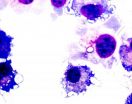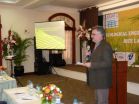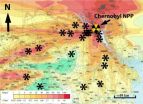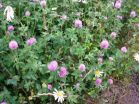(Press-News.org) Using a powerful data-crunching technique, Johns Hopkins researchers have sorted out how a protein keeps defective genetic material from gumming up the cellular works. The protein, Dom34, appears to "rescue" protein-making factories called ribosomes when they get stuck obeying defective genetic instructions, the researchers report in the Feb. 27 issue of Cell.
"We already knew that binding to Dom34 makes a ribosome split and say 'I'm done,' and that without it, animals can't survive," says Rachel Green, Ph.D., a professor in the Department of Molecular Biology and Genetics at the Johns Hopkins University School of Medicine and a Howard Hughes Medical Institute investigator. "In this study, we saw how the protein behaves in 'real life,' and that it swoops in only when ribosomes are in a very particular type of crisis."
Ribosomes use genetic instructions borne by long molecules called messenger RNA to make proteins that cells need to get things done. Normally, ribosomes move along strands of messenger RNA, making proteins as they go, until they encounter a genetic sequence called a stop codon. At that point, the protein is finished, and specialized recycling proteins help the ribosome disconnect from the RNA and break up into pieces.
Those pieces later come together again on a different RNA strand to begin the process again. From Green's earlier work with Dom34, it appeared that the protein might be one of the recycling proteins that kicks in at stop codons.
To see if that was the case, Green used a method for analyzing the "footprints" of ribosomes developed at the University of California, San Francisco. In 2009, scientists there reported they had mashed up yeast (a single-celled organism that is genetically very similar to higher-order animals) and dissolved any RNA that wasn't protected inside a ribosome at the time. They then took the remaining bits of RNA — those that had been "underfoot" of ribosomes — and analyzed their genetic makeup. That sequence data was then matched to the messenger RNA it came from, giving the researchers a picture of exactly which RNA — and thus, which genes — were being turned into protein at a given moment in time.
Green and postdoctoral fellow Nick Guydosh, Ph.D., adapted this method to see what Dom34 was up to. Guydosh wrote a computer program to compare footprint data from yeast with and without functioning Dom34 genes. The program then determined where on messenger RNAs the ribosomes in cells without Dom34 tended to stall. It was at these points that Dom34 was rescuing the ribosomes in the normal cells, Guydosh says.
"What many of these 'traffic jams' had in common was that the RNA lacked a stop codon where the ribosome could be recycled normally," he says. For example, some of the problem messenger RNAs were incomplete — a common occurrence, as chopping up messenger RNAs is one way cells regulate how much of a protein is produced.
In others, the RNA had a stop codon, but something strange and unexpected was going on in these latter cases: The ribosomes kept going past the place where the stop codon was and went into a no man's land without protein-making instructions. "Ribosomes kept moving but stopped making protein, at least for a time," Guydosh says. "As far as we know, this 'scanning' activity has never been seen before — it was a big surprise."
"What these results show us is why we need Dom34 to survive: It's the only protein that can rescue ribosomes stuck on RNAs," says Green. "Without it, cells eventually run out of the ribosomes they need to make protein."
INFORMATION:
Link to the Cell paper: http://www.cell.com/abstract/S0092-8674%2814%2900162-7
This study was funded by the National Institute of General Medical Sciences (grant number R01GM059425), the Howard Hughes Medical Institute and the Damon Runyon Cancer Research Foundation.
Related stories:
Biography of Rachel Green
The Complex Choreography of Protein Translation
Argonautes: A Big Turn-Off for Proteins
Lost in Translation
Protein 'rescues' stuck cellular factories
2014-03-19
ELSE PRESS RELEASES FROM THIS DATE:
International team of LHC and Tevatron scientists announces first joint result
2014-03-19
Scientists working on the world's leading particle collider experiments have joined forces, combined their data and produced the first joint result from Fermilab's Tevatron and CERN's Large Hadron Collider (LHC), past and current holders of the record for most powerful particle collider on Earth.
Scientists from the four experiments involved—ATLAS, CDF, CMS and DZero—announced their joint findings on the mass of the top quark on March 19, 2014 at the Rencontres de Moriond international physics conference in Italy.
Together the four experiments pooled their data analysis ...
Social feedback loop aids language development
2014-03-19
Verbal interactions between parents and children create a social feedback loop important for language development, according to research forthcoming in Psychological Science, a journal of the Association for Psychological Science. That loop appears to be experienced less frequently and is diminished in strength in interactions with autistic children.
"This loop likely has cascading impacts over the course of a child's development," says psychological scientist and study author Anne S. Warlaumont of the University of California, Merced. "Understanding how it works and ...
Geosphere presents articles examining lithospheric evolution and geologic history
2014-03-19
Boulder, Colo., USA – Geosphere articles posted online 17 Mar. 2014 include additions to two series: "CRevolution 2: Origin and Evolution of the Colorado River System II" and "Origin and Evolution of the Sierra Nevada and Walker Lane." Other articles present new seismic data for the Slate Range of California, USA; the first detailed geologic map from the Likhu Khola region of east central Nepal; and a review of pre-21st century ideas about the origin of Grand Canyon.
Abstracts for these and other Geosphere papers are available at http://geosphere.gsapubs.org/. Representatives ...
Low doses of antianxiety drugs rebalance the autistic brain
2014-03-19
New research in mice suggests that autism is characterized by reduced activity of inhibitory neurons and increased activity of excitatory neurons in the brain, but balance can be restored with low doses of a well-known class of drugs currently used in much higher doses to treat anxiety and epileptic seizures. The findings, which are reported in the March 19th issue of the Cell Press journal Neuron, point to a new therapeutic approach to managing autism.
"These are very exciting results because they suggest that existing drugs—called benzodiazepines—might be useful in ...
Fetal Alcohol Spectrum Disorders (FASD): An under-recognized issue that may be on the rise
2014-03-19
March 19, 2014 – The open-access International Journal of Alcohol and Drug Research has released a special issue on Fetal Alcohol Spectrum Disorders (FASD), with the intention of increasing awareness of the negative effects of alcohol use in pregnancy and improving prevention, treatment and care for those living with FASD.
"In most countries, FASD is not well recognized by health professionals," says guest editor Dr. Svetlana (Lana) Popova, Senior Scientist in the Social and Epidemiological Research Department at the Centre for Addiction and Mental Health (CAMH). "If ...
Study describes first maps of neural activity in behaving zebrafish
2014-03-19
In a study published today (19/3/2014) in the scientific journal Neuron, neuroscientists at the Champalimaud Foundation, in collaboration with neuroscientists from Harvard University, describe the first activity maps at the resolution of single cells and throughout the entire brain of behaving zebrafish.
"This opens up new possibilities for studying neural circuits in the brain," says Michael Orger, principal investigator at the Champalimaud Neuroscience Programme. "In order to understand how the brain works, it is imperative that we can record the activity of the cells ...
Researchers uncover allergy-cancer connection
2014-03-19
While many are stocking up on allergy medicine in preparation for spring, a new study from researchers at Virginia Commonwealth University Massey Cancer Center has uncovered a new connection between allergy and cancer that could potentially lead to therapies involving common antihistamines.
Recently published in the Journal of Leukocyte Biology, the study was led by Daniel H. Conrad, Ph.D., member of the Cancer Cell Signaling research program at Massey and professor of microbiology and immunology at the VCU School of Medicine, with substantial contributions from Ph.D. ...
Growing rice the sustainable way: LEGATO holds its 3rd annual conference
2014-03-19
In a world facing the challenges of climate change, demographic boom and deficit in food resources, the word "sustainable" and the concept behind it become increasingly relevant. Sustainability in the way humanity uses available resources is key to a brighter and greener future.
In the context of sustainable food production, there is a clear need for crop productivity increases and diversification. Optimising rice ecosystem functions and services in Southeast Asia and their stabilisation under future land use and climate change, is the main focus of the project LEGATO ...
Radiation damage at the root of Chernobyl's ecosystems
2014-03-19
Radiological damage to microbes near the site of the Chernobyl disaster has slowed the decomposition of fallen leaves and other plant matter in the area, according to a study just published in the journal Oecologia. The resulting buildup of dry, loose detritus is a wildfire hazard that poses the threat of spreading radioactivity from the Chernobyl area.
Tim Mousseau, a professor of biology and co-director of the Chernobyl and Fukushima Research Initiatives at the University of South Carolina, has done extensive research in the contaminated area surrounding the Chernobyl ...
Research reveals true value of cover crops to farmers, environment
2014-03-19
Planting cover crops in rotation between cash crops -- widely agreed to be ecologically beneficial -- is even more valuable than previously thought, according to a team of agronomists, entomologists, agroecologists, horticulturists and biogeochemists from Penn State's College of Agricultural Sciences.
"As society places increasing demands on agricultural land beyond food production to include ecosystem services, we needed a new way to evaluate 'success' in agriculture," said Jason Kaye, professor of biogeochemistry. "This research presents a framework for considering ...




